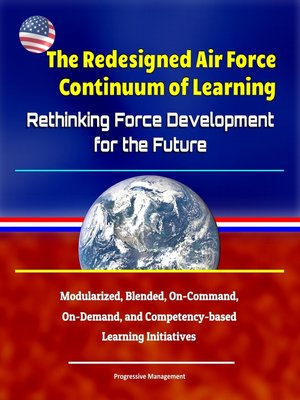The Redesigned Air Force Continuum of Learning
ebook ∣ Rethinking Force Development for the Future--Modularized, Blended, On-Command, On-Demand, and Competency-based Learning Initiatives

Sign up to save your library
With an OverDrive account, you can save your favorite libraries for at-a-glance information about availability. Find out more about OverDrive accounts.
Find this title in Libby, the library reading app by OverDrive.



Search for a digital library with this title
Title found at these libraries:
| Library Name | Distance |
|---|---|
| Loading... |
This report has been professionally converted for accurate flowing-text e-book format reproduction. The USAF Strategic Master Plan posited five strategic vectors to help prioritize investments, drive institutional change, and operationalize key concepts. These included providing effective twenty-first-century deterrence; maintaining a robust and flexible global intelligence, surveillance, and reconnaissance (ISR) capability; ensuring a full-spectrum capable, high-end focused force; pursuing a multidomain approach to the Air Force's five core missions; and continuing to pursue game-changing technologies. Arguably Air Education and Training Command (AETC) supports all of these vectors; however, the call for a full-spectrum capable, high-end focused force falls squarely within the AETC mission. AETC was tasked with preparing for the future, yet much of what we deliver under the banner of force development is lodged in a learning paradigm that has not altered substantially since the creation of our service.
The Human Capital Annex states: World class application of airpower requires a highly specialized and competent workforce developed through deliberate training, education, and leadership experiences. The development of a technically competent Airman can take years and, as such, the Air Force must take steps to leverage and retain that investment. It is imperative that we develop a holistic strategy for attracting, recruiting, developing, and retaining the right Total Force Airmen that meet the needs of the Air Force in a cost effective way. . . . The need for Airmen who possess the right occupational skills and institutional competencies forms the core requirement of force development. Where occupational competencies are required to build technical depth, the Air Force's institutional competencies are key to ensuring the ability of Airmen to operate successfully in a constantly changing environment at the tactical, operational, and strategic levels.
The Air Force is not alone in facing the challenges and opportunities of the contemporary context. In his testimony to the House Armed Services Committee in June 2017, SecDef James Mattis noted the Department of Defense must "be prepared to deal with technological, operational, and tactical surprise, which requires changes to the way we train and educate our leaders and our forces." The depth and breadth of emergent threats and the potential of existent opportunities have driven all of the US military services to reconsider their operating concepts.







